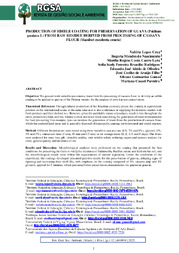Production of edible coating for preservation of guava (Psidium guaiava L) from raw residue derived from processing of cassava flour (Manihot esculenta crantz).
Production of edible coating for preservation of guava (Psidium guaiava L) from raw residue derived from processing of cassava flour (Manihot esculenta crantz).
Autoria: CRUZ, V. L.; NASCIMENTO, R. M. do; LYRA, M. R. C. C.; RODRIGUES, S. S. F. B.; OLIVEIRA, E. J. A. de; ARAUJO FILHO, J. C. de; GOMES, S. G.; PARREIRA, M. C.
Resumo: Objective: The present work aimed to use crueira, waste from the processing of cassava flour, todevelop an edible coating to be applied to guavas of the Paluma variety, for the purpose of post-harvest conservation.Theoretical Reference: The agricultural production of the Brazilian economy places the country in a prominent position on the international scene, at the same time as it is also a reference in supplying the domestic market with fresh products and their derivatives. However, given the perishable nature of products, much is lost throughout the entire production chain, and this volume is even increased when considering the generation of waste recommended for food processing. For example, you can mention the generation of waste from the production of cassava flour, which has underutilized areas and is generally disposed of improperly, causing environmental and social impacts.Method: Different formulations were tested using three variables: cassava raw (6%, 7% and 8%), glycerol (3%, 4% and 5%), immersion time (5 min, 10 min and 15 min) in six storage times (0, 2, 4, 6 and 8 days). Our fruits were analyzed for mass loss, pH, titratable acidity, total soluble solids, reducing sugars and sensory analysis for color, general quality and incidence of rot.Results and Discussion: Microbiological analyses were performed on the coating that presented the best conditions for preserving the fruits to verify the incidence of Salmonella, Bacillus cereus and Escherichia coli, and the microbiological results were within the requirements of current legislation. Under the conditions of the experiment, the coatings developed presented positive results for the preservation of guavas, delaying signs of ripening and increasing their shelf life, with emphasis on the coating composed of 6% cassava pulp and 3% glycerol, applied for 5 minutes, which presented better preservation characteristics for guavas in general.
Ano de publicação: 2025
Tipo de publicação: Artigo de periódico
Unidade: Embrapa Solos
Palavras-chave: Cassava Crueira, Cassava flour, Conservação, Fruit Coating, Goiaba, Manihot Esculenta, Post-Harvest Preservation, Pós-Colheita, Resíduo, Wastes
Observações
1 - Por padrão são exibidas publicações dos últimos 20 anos. Para encontrar publicações mais antigas, configure o filtro ano de publicação, colocando o ano a partir do qual você deseja encontrar publicações. O filtro está na coluna da esquerda na busca acima.
2 - Para ler algumas publicações da Embrapa (apenas as que estão em formato ePub), é necessário ter, no celular ou computador, um desses softwares gratuitos. Sistemas Android: Google Play Livros; IOS: iBooks; Windows e Linux: software Calibre.
Acesse outras publicações
Acesse a Base de Dados da Pesquisa Agropecuária (BDPA) para consultar o acervo completo das bibliotecas da Embrapa.

